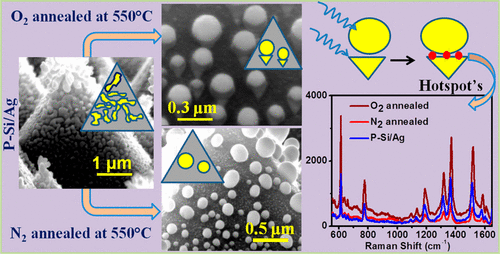当前位置:
X-MOL 学术
›
ACS Appl. Mater. Interfaces
›
论文详情
Our official English website, www.x-mol.net, welcomes your
feedback! (Note: you will need to create a separate account there.)
Annealing Induced Morphology of Silver Nanoparticles on Pyramidal Silicon Surface and Their Application to Surface-Enhanced Raman Scattering
ACS Applied Materials & Interfaces ( IF 8.3 ) Pub Date : 2017-09-20 00:00:00 , DOI: 10.1021/acsami.7b08493 Abhijit Roy 1 , Arpan Maiti 1 , Tapas Kumar Chini 1 , Biswarup Satpati 1
ACS Applied Materials & Interfaces ( IF 8.3 ) Pub Date : 2017-09-20 00:00:00 , DOI: 10.1021/acsami.7b08493 Abhijit Roy 1 , Arpan Maiti 1 , Tapas Kumar Chini 1 , Biswarup Satpati 1
Affiliation

|
This paper reports on a simple and cost-effective process of developing a stable surface-enhanced Raman scattering (SERS) substrate based on silver (Ag) nanoparticles deposited on silicon (Si) surface. Durability is an important issue for preparing SERS active substrate as silver nanostructures are prone to rapid surface oxidation when exposed to ambient conditions, which may result in the loss of the enhancement capabilities in a short period of time. Here, we employ the galvanic displacement method to produce Ag nanoparticles on Si(100) substrate prepatterned with arrays of micropyramids by chemical etching, and subsequently, separate pieces of such substrates were annealed in oxygen and nitrogen environments at 550 °C. Interestingly, while nitrogen-annealed Si substrates were featured by spherical-shaped Ag particles, the oxygen annealed Si substrates were dominated by the formation of triangular shape particles attached with the spherical one. Remarkably, the oxygen-annealed substrate thus produced shows very high SERS enhancement compared to the either unannealed or nitrogen annealed substrate. The hitherto unobserved coexistence of triangular morphology with the spherical one and the gap between the two (source of efficient hot-spots) are the origin of enhanced SERS activity for the oxygen-annealed Ag particle-covered Si substrate as probed by the combined finite-difference time domain (FDTD) simulation and cathodoluminesensce (CL) experiment. As the substrate has already been annealed in an oxygen environment, further probability of oxidation is reduced in the present synthesis protocol that paves the way for making a novel long-lived thermally stable SERS substrate.
中文翻译:

金字塔形硅表面上银纳米粒子的退火诱导形貌及其在表面增强拉曼散射中的应用
本文报道了一种基于沉积在硅(Si)表面上的银(Ag)纳米粒子的稳定表面增强拉曼散射(SERS)基板的开发方法,该方法简单且具有成本效益。耐用性是制备SERS活性基材的重要问题,因为银纳米结构在暴露于环境条件下时容易发生快速的表面氧化,这可能会导致在短时间内丧失增强能力。在这里,我们采用电流置换法在通过化学蚀刻预先图案化为微金字塔阵列的Si(100)基板上生产Ag纳米粒子,随后,在550°C的氧气和氮气环境中对此类基板的各个部分进行退火。有趣的是,尽管氮退火的Si衬底具有球形Ag颗粒的特征,氧退火的硅衬底主要由与球形衬底相连的三角形颗粒形成。显着地,与未退火或氮退火的基材相比,如此制得的氧退火的基材显示出非常高的SERS增强。迄今为止,从未观察到的球形与三角形形态以及两者之间的间隙(有效热点的来源)共存的三角形形态,是由氧退火的覆盖有Ag颗粒的Si衬底增强的SERS活性的根源,这是由有限元法和有限元法相结合所探测到的。时域(FDTD)模拟和阴极发光(CL)实验。由于基材已经在氧气环境中进行了退火,
更新日期:2017-09-20
中文翻译:

金字塔形硅表面上银纳米粒子的退火诱导形貌及其在表面增强拉曼散射中的应用
本文报道了一种基于沉积在硅(Si)表面上的银(Ag)纳米粒子的稳定表面增强拉曼散射(SERS)基板的开发方法,该方法简单且具有成本效益。耐用性是制备SERS活性基材的重要问题,因为银纳米结构在暴露于环境条件下时容易发生快速的表面氧化,这可能会导致在短时间内丧失增强能力。在这里,我们采用电流置换法在通过化学蚀刻预先图案化为微金字塔阵列的Si(100)基板上生产Ag纳米粒子,随后,在550°C的氧气和氮气环境中对此类基板的各个部分进行退火。有趣的是,尽管氮退火的Si衬底具有球形Ag颗粒的特征,氧退火的硅衬底主要由与球形衬底相连的三角形颗粒形成。显着地,与未退火或氮退火的基材相比,如此制得的氧退火的基材显示出非常高的SERS增强。迄今为止,从未观察到的球形与三角形形态以及两者之间的间隙(有效热点的来源)共存的三角形形态,是由氧退火的覆盖有Ag颗粒的Si衬底增强的SERS活性的根源,这是由有限元法和有限元法相结合所探测到的。时域(FDTD)模拟和阴极发光(CL)实验。由于基材已经在氧气环境中进行了退火,

































 京公网安备 11010802027423号
京公网安备 11010802027423号